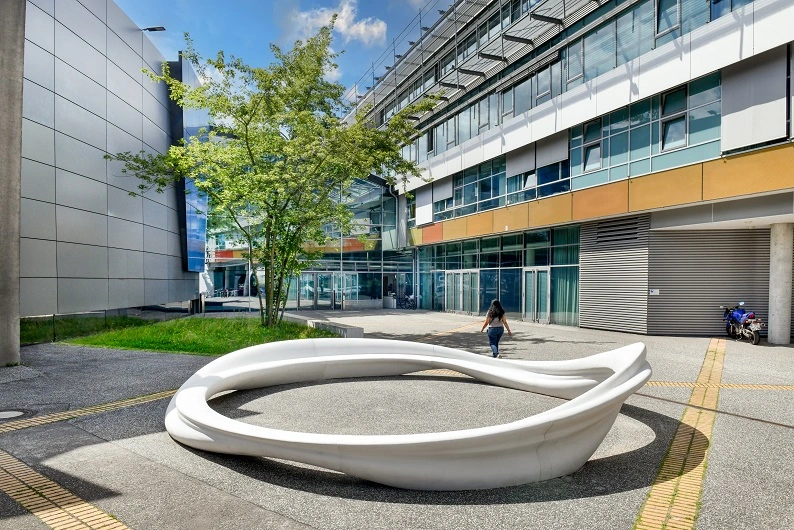A dynamic seating area for brainstorming
Peter Sandhaus builds a bridge between science, art, and communication in front of BESSY II
Science doesn’t only happen behind closed lab doors; flashes of inspiration can strike anywhere. With his “Neuron Accelerator”, Peter Sandhaus has created a new space for fast-moving thoughts to unfold. While electrons are accelerated close to the speed of light inside the circular tunnel of BESSY II, the dynamic energy of the electron storage ring is reflected in Sandhaus’s sculpture installed in front of the facility. The circular, marble-white “Neuron Accelerator” creates a space for encounters and invites people to get brainstorming together. The artist hopes that, “this will really become a meeting place that gets used intensively.”
Firing neurons
The name is a deliberate play on words. “The likelihood of confusing it with the word ‘neutron’ is intentional,” Sandhaus explains with a wink. “I want people to stumble over the term, and in that way, get their neurons firing.” Peter Sandhaus came first in the “Art Meets Science” competition. Wining factors of his project were the sculpture’s high potential for interaction and the shared identity between the “Neuron Accelerator” and the facility behind it.
The conceptual artist likes working with places whose meanings he can explore and emphasize through his works. At the University Hospital in Regensburg, Sandhaus’s “Antibody” (2019) made of red, wavy aluminium grows out from the facade of the immunology lab. In Frankfurt’s Gateway Gardens, his mirror-polished “Highflyer” (2023), shaped like a paper aeroplane, echoes the nearby airport while acting as a contrast to the round, organic architecture of the FLOW Europa-Center.
And in the same vein, at BESSY II, Sandhaus captures the spirit of the site in an “embodiment”. “This takes an abstract idea, a symbol, or a dimension of meaning that’s relevant here and gives it a tangible, physical form.” As a former architect, he creates organically spherical spaces of experience, carefully selecting the right materials for each piece. In this instance, he chose white-pigmented high-performance concrete to enhance the rough concrete facade of BESSY II with an elegant, participatory artwork.
Challenging construction
Creating the mould turned out to be more challenging than anticipated. If Sandhaus had used 3D-printed sand moulds, as envisaged, the surface of the “Neuron Accelerator” would have come out too grainy – and not even sandblasting would have achieved the desired smoothness. Ironically, he opted for a more complex process, but had the support of Swiss company dade design: “Each individual segment was assembled from at least three different moulds. First, a positive mould was machined out of rigid foam. This was cast over with fiberglass-reinforced plastic in three separate pieces, which were inverted, put into wood-reinforced shells and then filled with concrete.” These moulds were resanded and spackled many times throughout the process, Sandhaus recounts. The sculpture consists of eight separate parts, and the concrete is self-compacting.
During installation, the eight segments were pieced together like a puzzle. They rest on eight screw piles, allowing the asphalt below to remain intact – otherwise, large areas would have had to be removed to make way for concrete foundations. The precast elements were slid together with dovetail joints and sealed. The requisite expansion joints were filled with silicone. Now, the artwork is complete, reaching up to 1.3 meters tall. A hydrophobic coating and algae-resistant treatment keep the surface pleasant to sit on even after rain. Over time, the “Neuron Accelerator” will develop a natural patina. But the ideas that emerge there will shine brightly – and help to bring about further progress.
Contact:
Helmholtz-Zentrum Berlin für Materialien und Energie
Dr. Ina Helms
Head of Communications and Spokesperson
+49 30 8062-42034
ina.helms(at)helmholtz-berlin.de
www.helmholtz-berlin.de
HZB news, 18.09.2025

